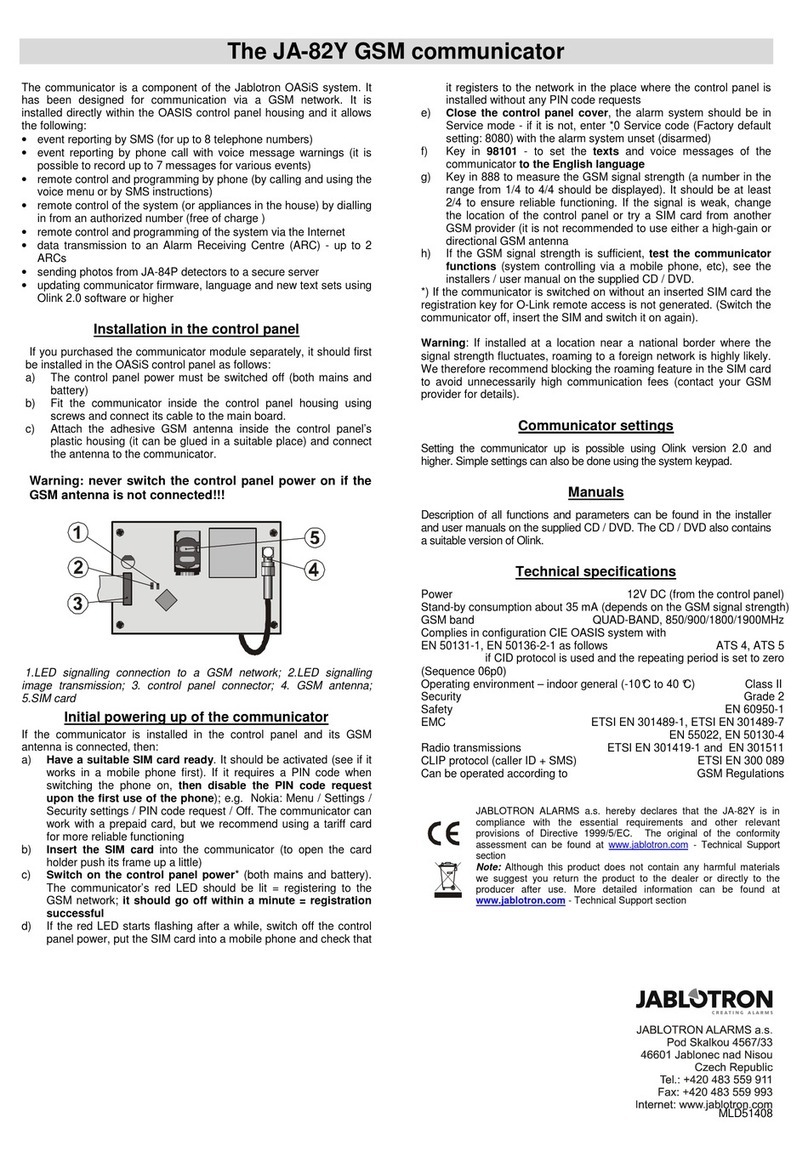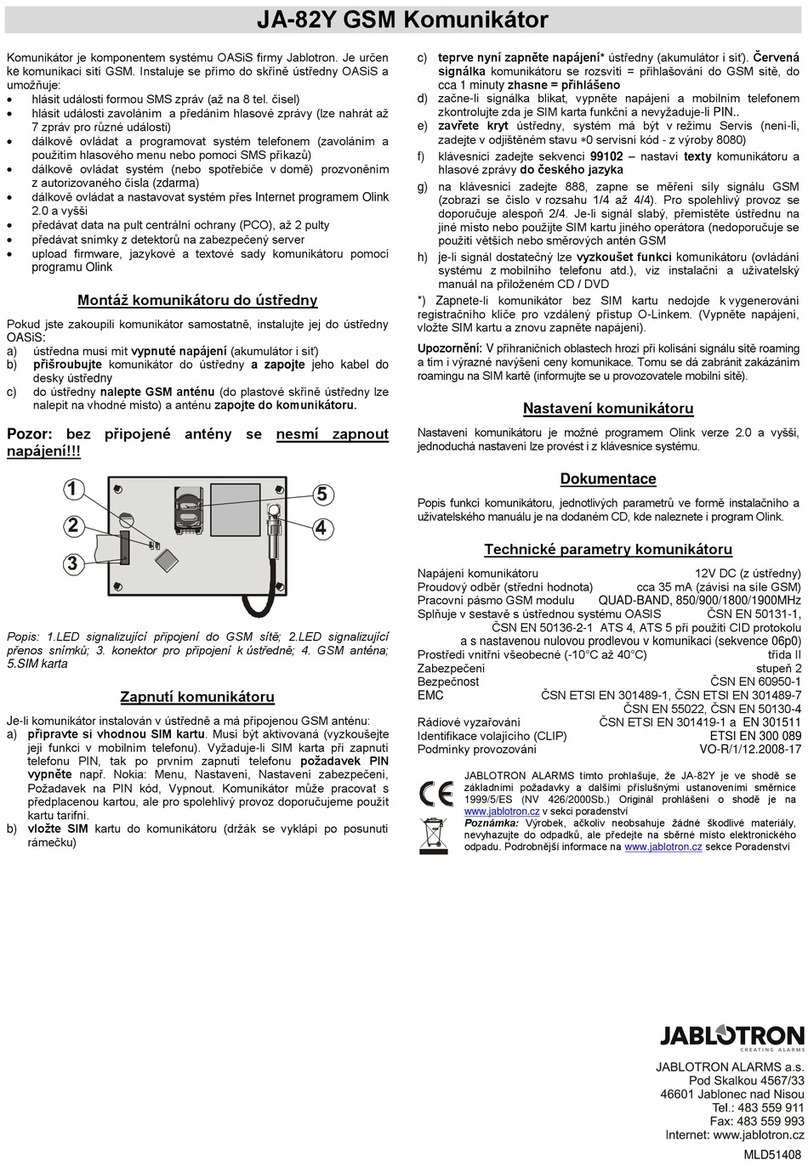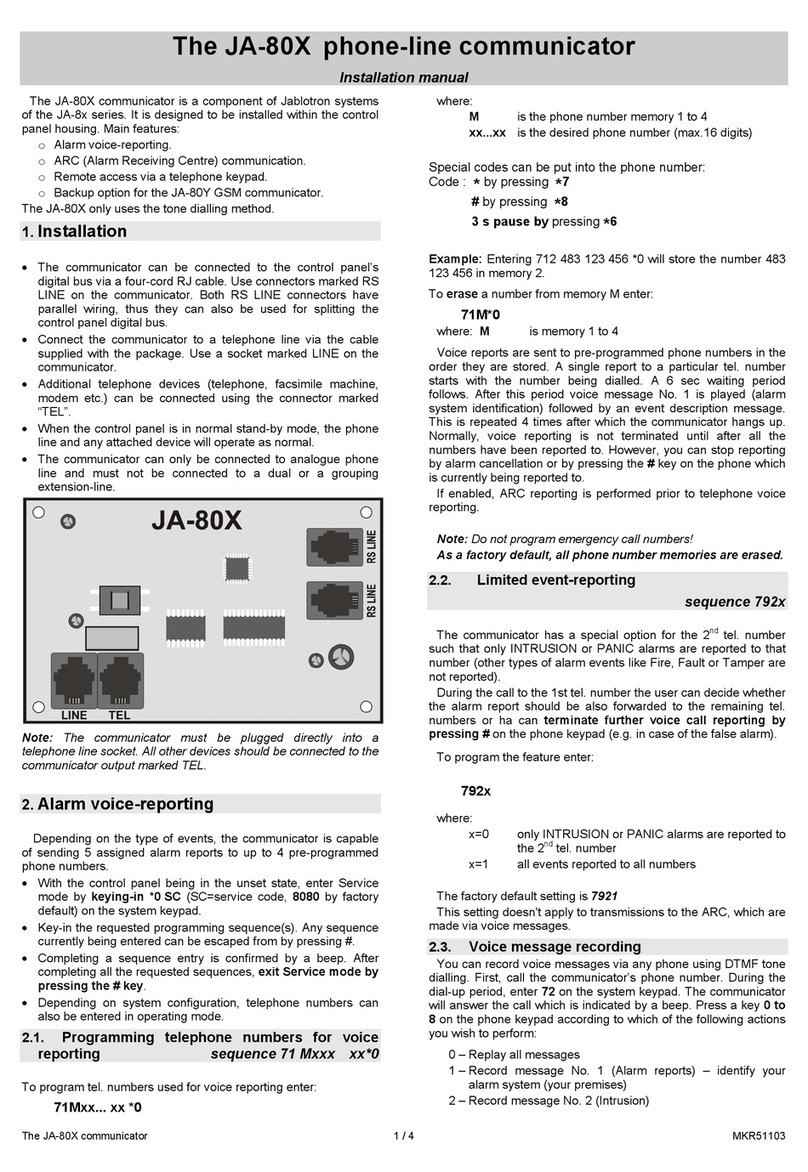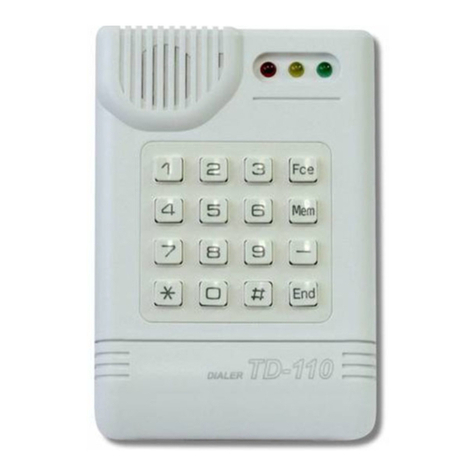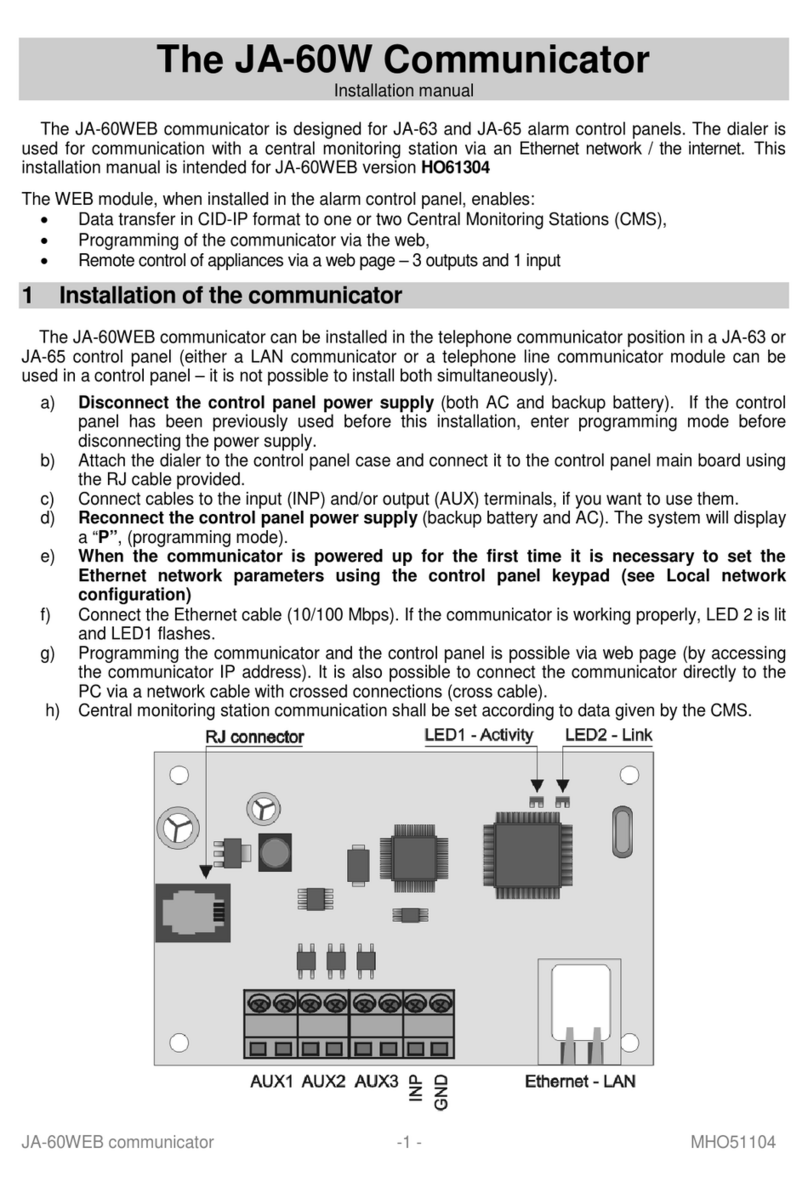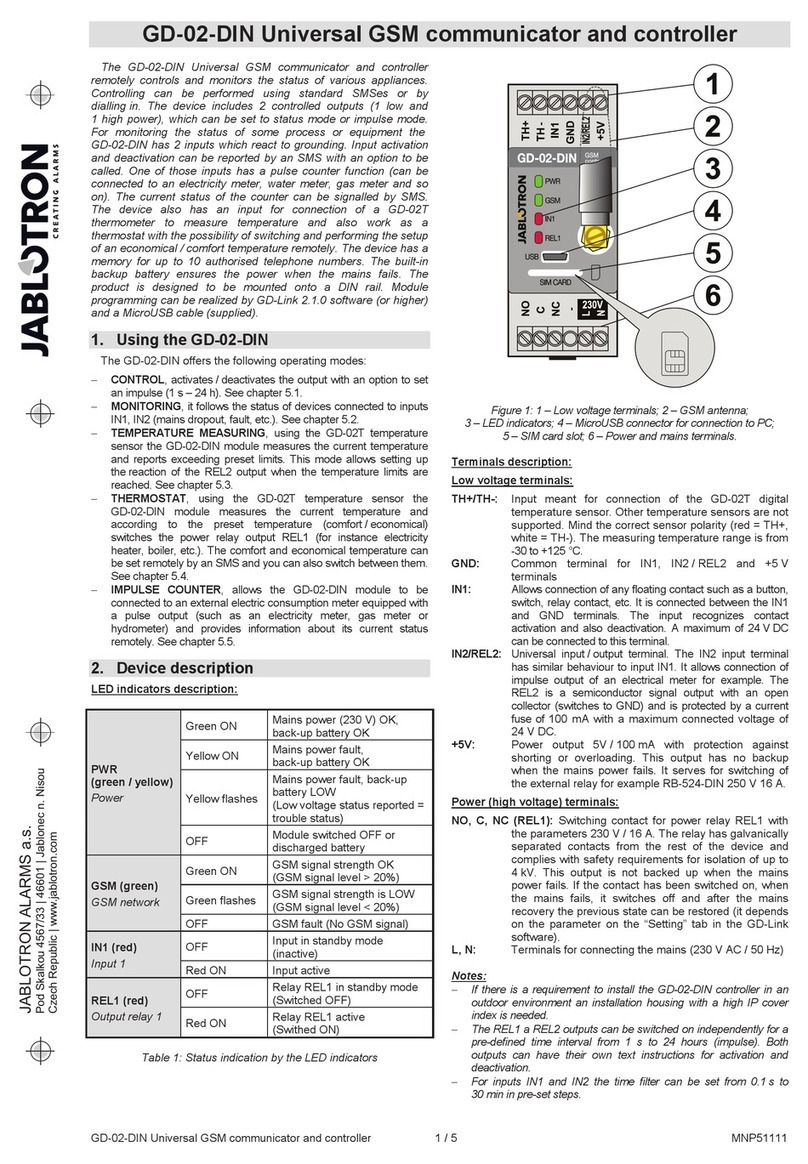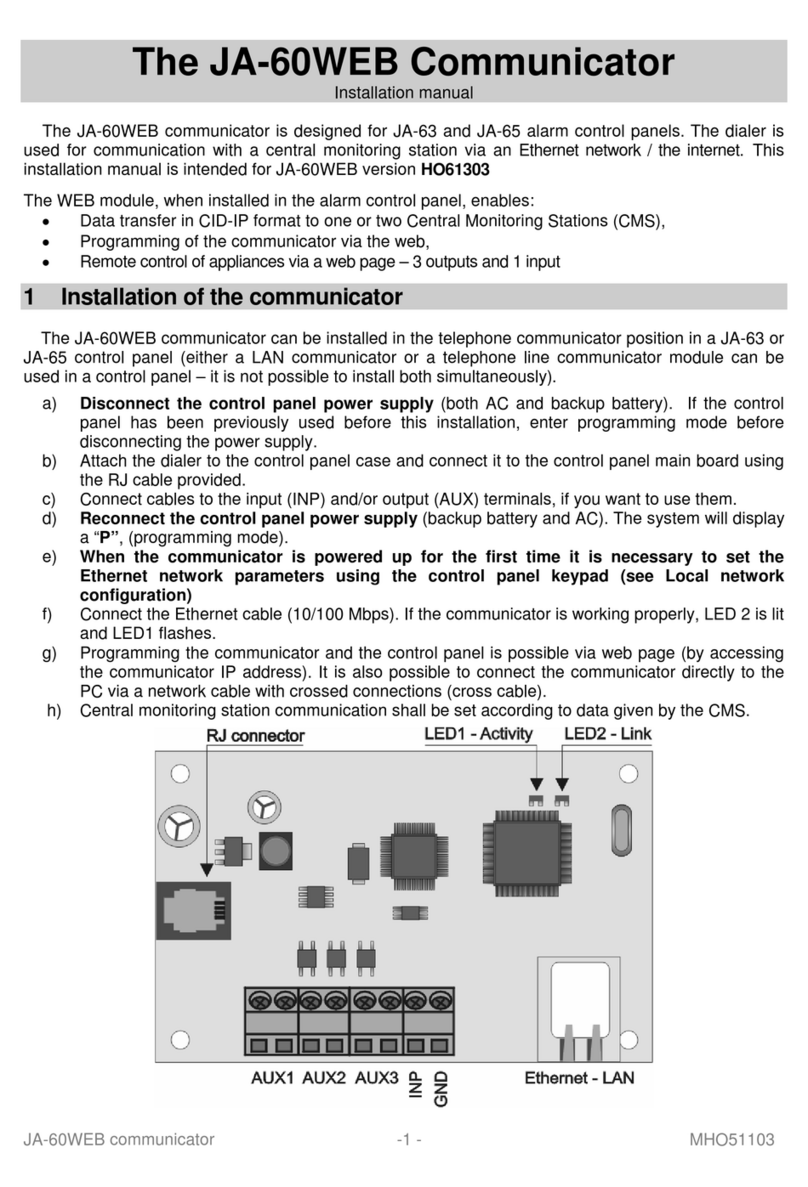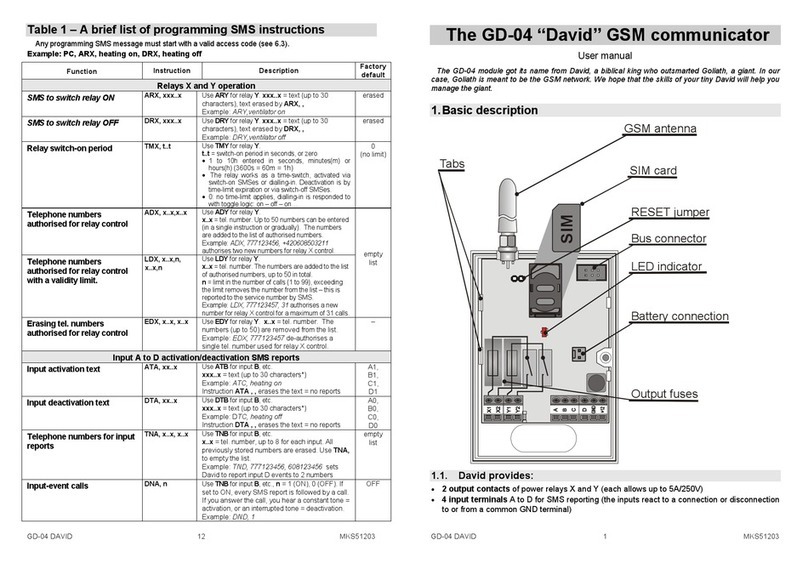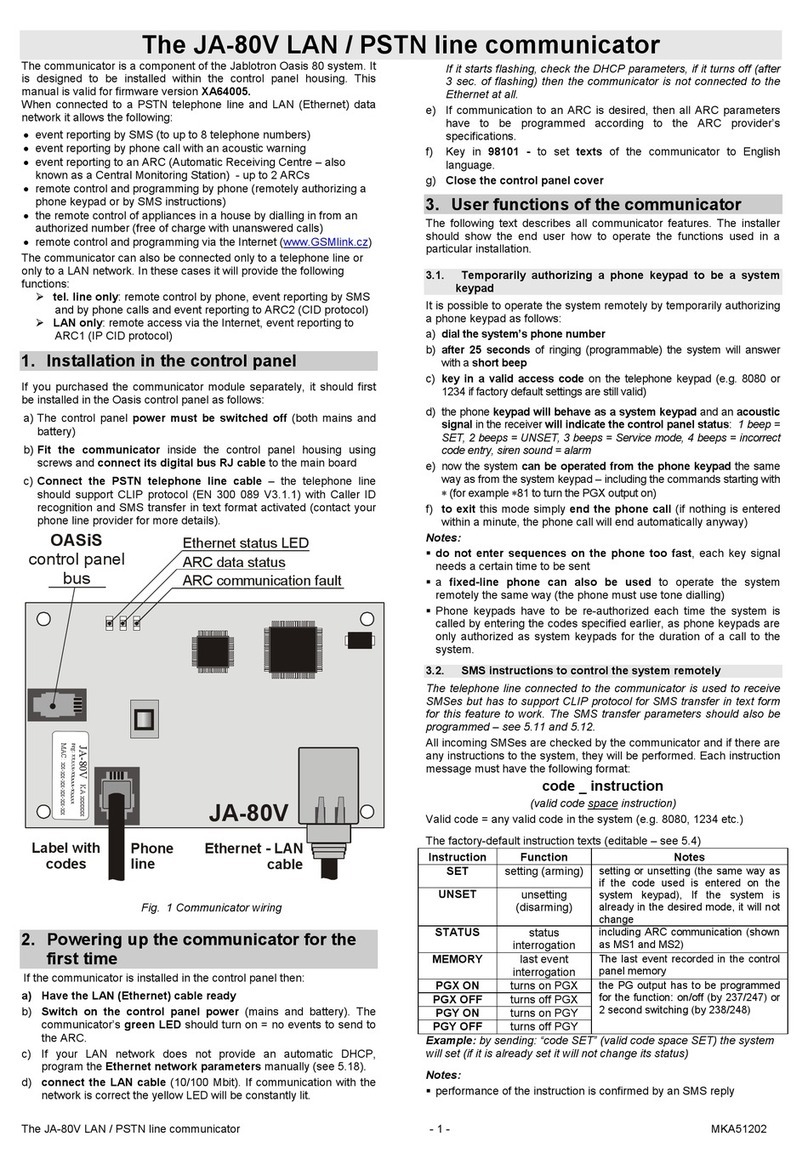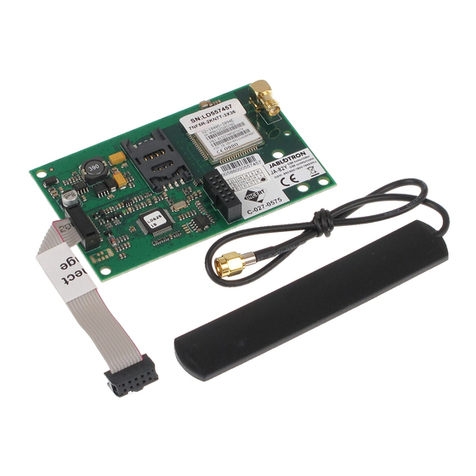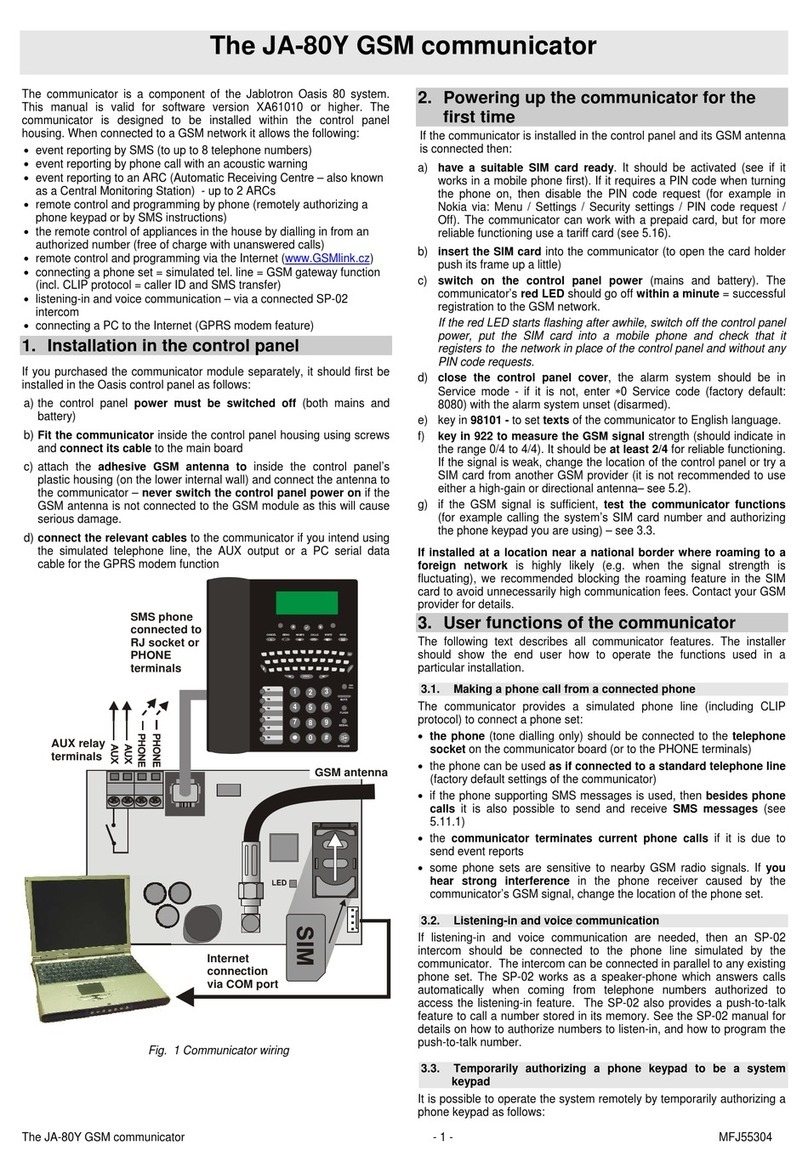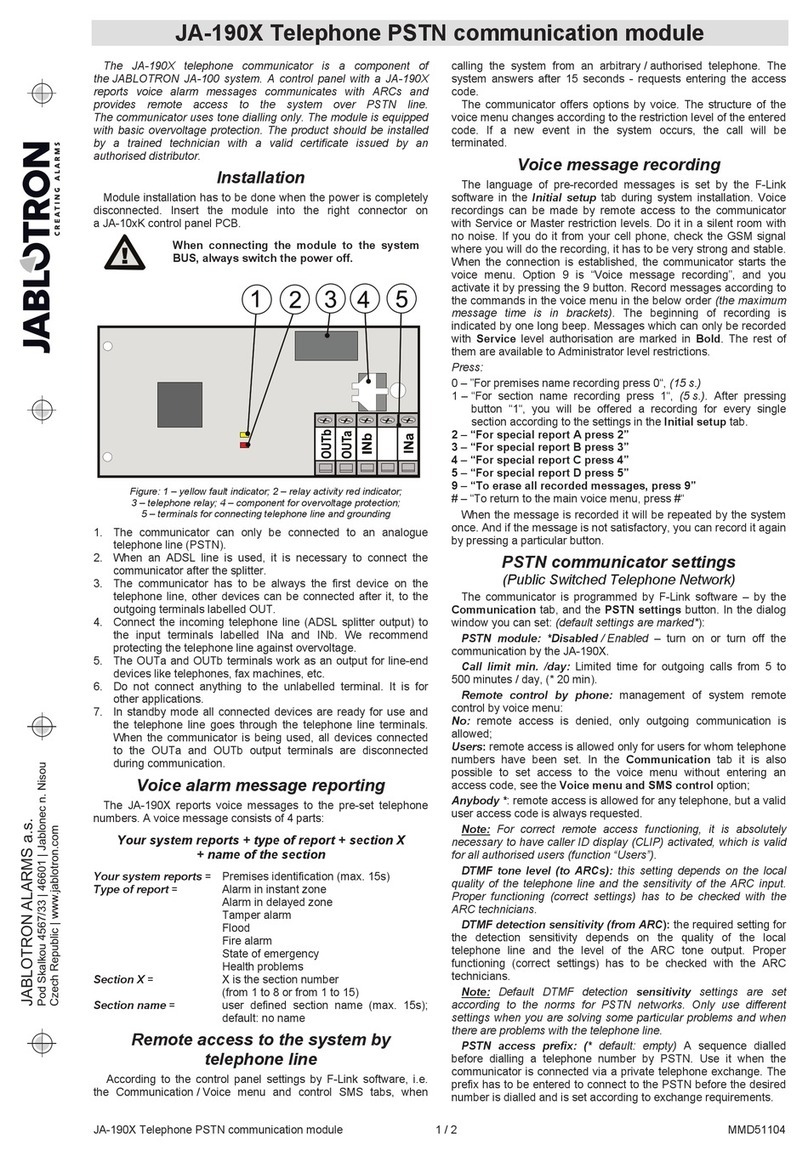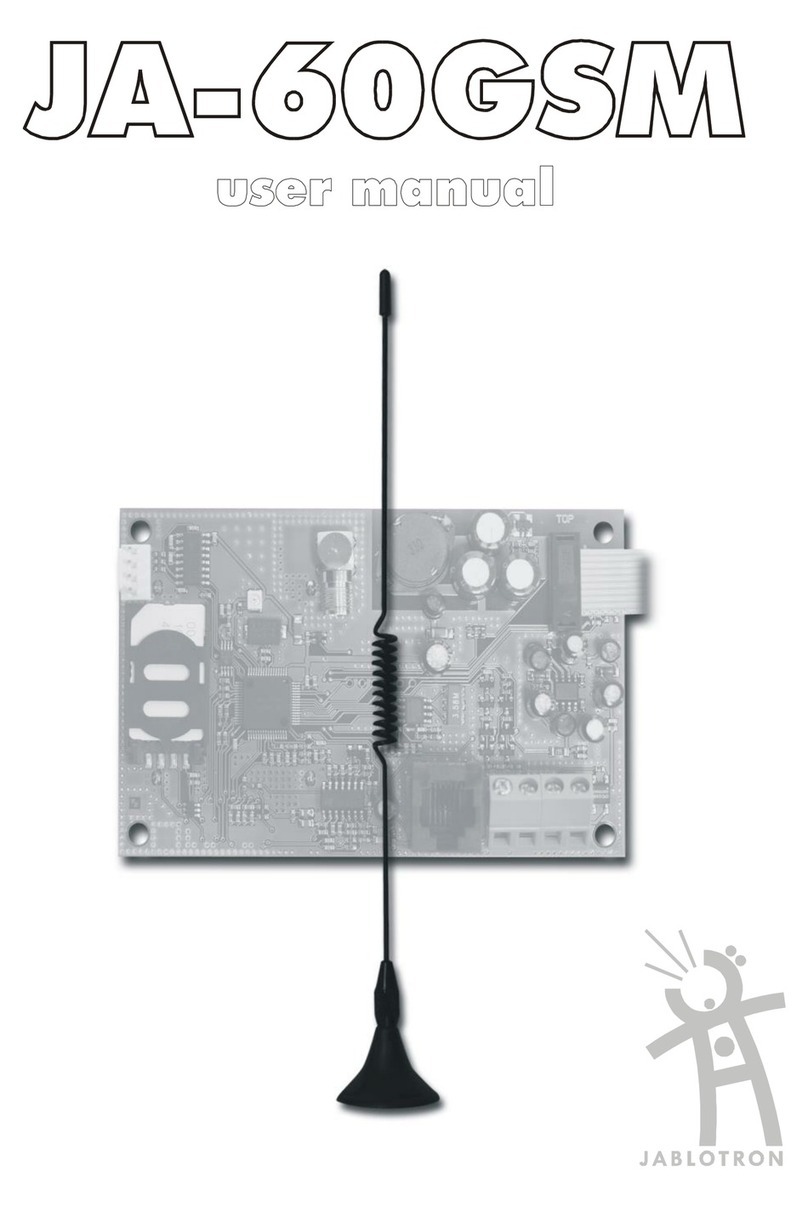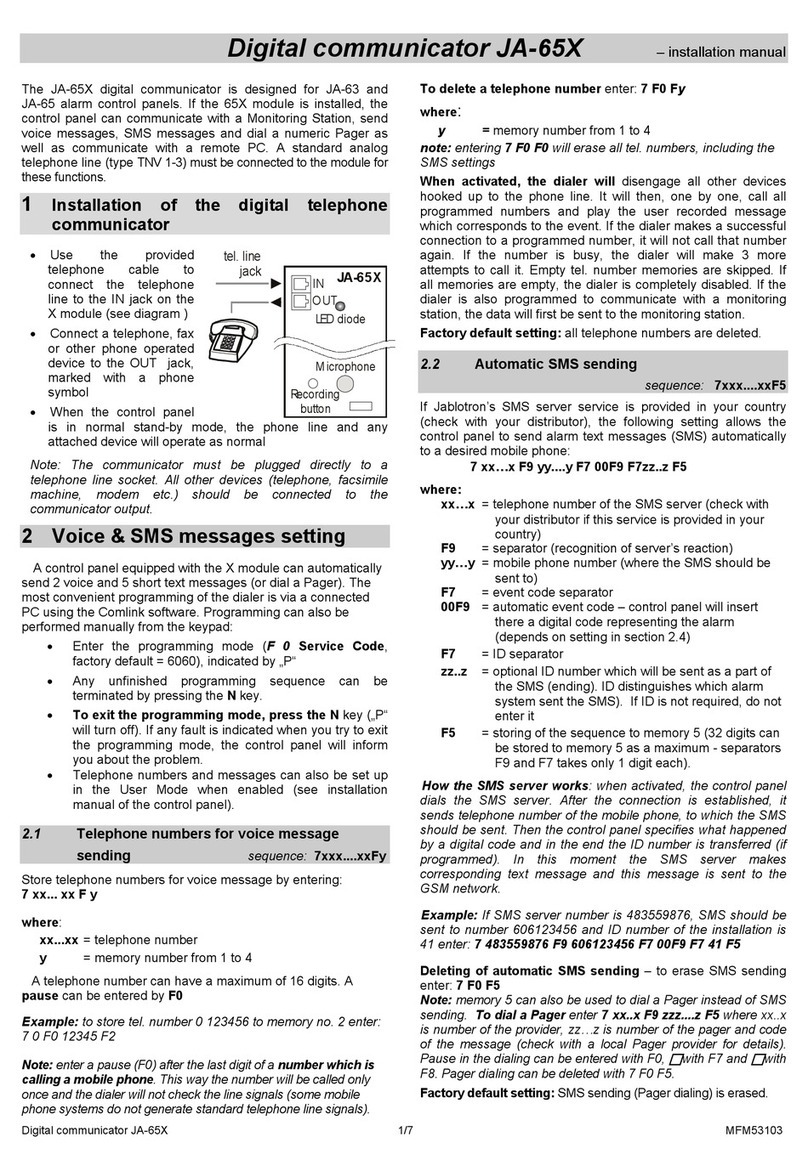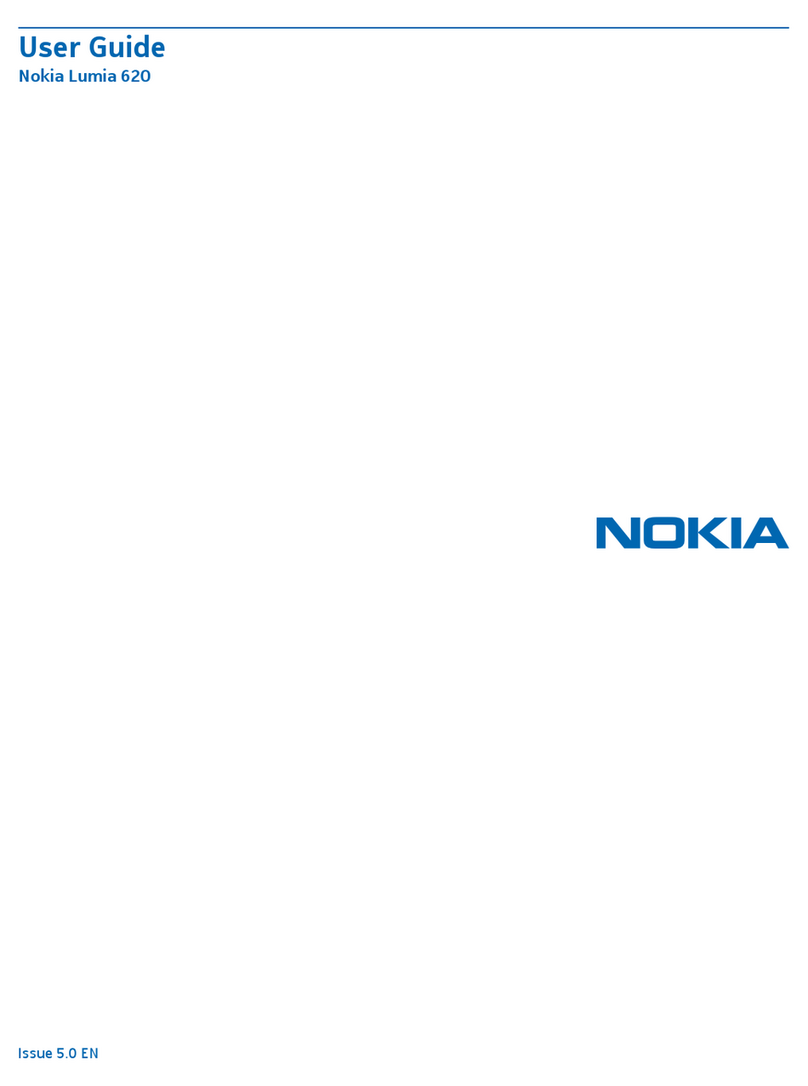
The JA-62GSM communicator for GSM
The JA-62GSM communicator for GSM 3 / 11 MLD52902
mode allows users to find a suitable location for the communicator antenna.
Press the # key to exit the measuring.
The signal should be at least 3. In places with a weak signal we
recommend trying another GSM provider’s SIM card.
Warning: it is not recommended to use a directional GSM antenna
with the communicator (the module would thus communicate with a
single cellular base station only). The communicator normally
communicates with at least three cellular base stations (the connection
is thus more stable). It is not even recommended to use a high-gain
antenna – if the signal is transmitted over a distance exceeding 30km, it
does not ensure standard GSM function due to time lapses in the
transmission.
6.3. Setting of telephone numbers and events
The factory-default list of reported events and their assignment to
telephone numbers M1 to M8 (tab. 1) can be modified. The complete list of
reportable events is shown in Tab 6.
It is possible to select whether the event should be reported by an SMS or
by a phone call, or in both ways.
Each event has pre-programmed factory-default SMS text (it can be
modified – see 6.7).
6.4. SMS report setting
To set events to being reported by SMS, enter:
82 M uu x
where: M is phone number memory 1 to 8
uu event code 01 to 40 (see tab. 5)
x0 = no SMS report, 1 = SMS report
Example: If 82 8 03 1 is programmed and a fire alarm is triggered (event 03
in the table), it will be reported by SMS to the phone number stored in
memory M8.
6.5. Voice message setting
To set events to being reported by voice messages, enter:
83 M uu x
where:Mis phone number memory 1 to 8
uu event code 01 to 40 (see tab. 5)
x0 = no phone call, 1 = call
Example:if 83 1 03 1 is programmed and a fire alarm is triggered (event 03
in the table), the communicator will phone the first number stored in the
memory and it will keep repeating: Your system is reporting a fire alarm.
Notes:
−Calling is usually used to draw the user’s attention to a detailed report
sent in an SMS. If reporting by SMS is enabled, the communicator first
sends all SMS messages before it starts dialling.
−If used, transmissions to the Alarm Receiving Centre have absolute
transmission priority (see 7.4).
−The message playing can be terminated by pressing # on the telephone
keypad. The keypad then switches into keypad simulation mode and the
messages are not further transmitted to other numbers.
6.6. Access code assignment to programmed telephone
numbers
This parameter serves for identification of the user during a voice call. To
do so, enter:
84 M xxxx
where: Mis phone number memory 0 to 8
xxxx Valid code UC / MC / SC
Notes:
−Entered codes don´t have to match the user code defined in the control
panel
−Position 0 = service code for remote access,
Factory default setting: No code, 0000 – service code for remote acc
6.7. SMS and instruction text editing
The communicator contains various factory default text strings which are
used to create SMS reports and also SMS instruction texts. The language of
the text can be set – see 6.1. These text strings can be edited locally by
ComLink software or remotely by sending the following SMS instruction:
code_TXT_n,text,n,text,......n,text
where: Code is a valid service code for remote access (default 0000)
_space
TXT is an instruction to edit texts
Ntext number (0 to 611, see tab. 6)
,comma (or full stop)
text the new text (max. 30 characters) which will replace the
former text. It is invalid to enter a comma or a full stop
inside the text string, but a space is valid within the text
string (spaces outside the text string are ignored).
Notes:
−A single SMS TXT instruction can modify multiple texts (limited only by
the maximum length of a single SMS)
−the communicator is not case-sensitive and it is recommended to use
only English ASCII characters (some networks do not support non-
English national characters)
−the communicator creates SMS reports with 5 parts (installation name,
event description, source number (code 01 to 14 or device 01 to 16),
source name and time. The maximum possible length of an ASCII SMS is
160 characters (only 70 characters for national characters) If this length is
exceeded, the report is sent as multiple SMSes.
−The communicator automatically fills in spaces, delimiters and time.
Examples:
if the factory default service code is 0000 then the SMS instruction:
0000 TXT 33,key fob Bob,34,Key fob Jane changes the description
(name) of the key fobs enrolled to addresses 33 and 34.
0000 TXT 609,heating on,610,heating off edits the text of the two
instructions used to command the heating to be switched on and off by the
PGX/Y output (the PG output must be programmed to have an PHONE
function).
6.8. Voice message recording
Recording a message is done by phone with the system in service mode.
Dial the system SIM card number. When the system answers, enter your
access code, then press 9 (keypad simulation) and enter *0 service code or
*0 Master code (unless you are in service / maintenance mode) and then
sequence 892. The communicator will report that you are in voice message
recording mode. You will hear regular beeping from the receiver; the
communicator is waiting for a key to be pressed:
0– replay all messages
1– Record message no. 1 (intruder alarm)
2– Record message no. 2 (fire alarm)
3– Record message no. 3 (tamper alarm)
4– Record message no.4 (panic alarm)
5– Record message no. 5 (fault alarm)
6– Record message no.6 (alarm report) – installation identification
7– Record message no.7 (other event)
8– delete all user recordings = reset to factory default recordings
When you press a key from 1 to 7, you will hear another beep and you can
start speaking. The end of recording is signalled with a beep and the
message is replayed. The communicator then returns to the main menu
(regular beeping) and it is possible to record further messages. The length of
message no.6 should not exceed 5 s, other messages should be 3 s long.
Press # to stop the voice recording menu and return to service /
maintenance mode.
Message no.7 is played upon each event which you set for a voice
message and which is not an alarm. The factory default message is: Other
event. i.e. is usually used to inform about sending an SMS. However, it can
also be used specifically for a particular event (e.g. it may be used to report
PG output control, etc. – it depends on the 83 M uu x settings see 6.5)
Notes:
−Listening to the message can be terminated by pressing the *key.
−To exit the message recording mode, just end the call.
−The messages are recorded in a memory which is not erased when the
system power supply is shut down.
−For events like setting / unsetting, the voice messages “Armed system”
, “Disarmed system” or “Partially armed” are reported; these
messages cannot be changed.
6.9. Quick enabling / disabling of reporting to phones
Event reports to your phone can be enabled / disabled as follows:
901 0 all SMS and call reports disabled
901 1 all SMS and call reports enabled
901 2 all reports enabled except reports of setting and unsetting by
users 1 to 4(i.e. their codes and key fobs). Master code control is
not reported either. This allows setting and unsetting done by
report recipients (owners, bosses, etc.) not to be reported.
Factory default setting: 9011 all reports enabled
